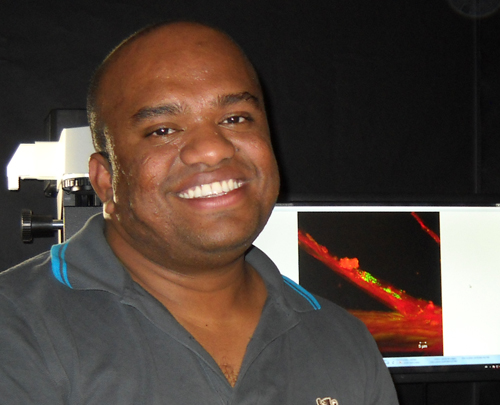
Imagine a doctor injecting a patient with swarms of biological robots so tiny that you can’t see them in order to treat diseases such as cancer, AIDS and diabetes.
That’s what Suresh Neethirajan hopes his work will help to bring about. The Guelph biological engineer is developing bio-nanorobots intended to travel through a patient’s bloodstream, zero in on individual tumour cells and deliver precise amounts of drugs to fight the cancer.
Using such devices, doctors might send only as much medication as needed directly to tumour cells. He says existing chemotherapy drugs can affect normal cells as well as cancerous ones, leading to organ damage and side effects such as hair loss.
“A major advantage of a nanorobot is that the volume of drug will be very minuscule and also site-specific,” he says. “This is an exciting and real-time application that can have a huge impact on the way health care is being conducted.”
In a paper published in Cancer Nanotechnology in July, he and his co-authors describe their design for an intelligent system to diagnose and treat tumours using bio-nanorobots. The paper’s lead author, Mark Fletcher, is a fourth-year student in biomedical engineering. Prof. Mohammad Biglarbegian is also a co-author.
The team designed simulated bio-nanorobots containing chambers for carrying drugs through the body. Nanorobots are on the scale of nanometres, or billionths of metres. Bio-nanorobots would consist of biological materials, including DNA or bits of protein.
Millions of these devices, each equipped with sensors and controllers, might be injected into a patient at the same time, says Neethirajan.
The Guelph team found their intelligent system enabled the robots to navigate through blood vessels while avoiding obstacles, identify tumours and deliver optimum drug dosages.
Tumour cells have different properties than normal ones, notably electromagnetism, temperature and chemicals. Inflamed tissues around cancer cells can be up to 2 C higher, for instance. In the U of G simulations, the robots were able to use those properties to distinguish between tumours and normal cells.
Protein molecules on the surface of tumour cells differ between cancer types. After finding a cancer cell and attaching itself to its surface, the team’s robot detected those markers to diagnose the particular cancer. The research used leukemia and lymphoma, two of the most common cancers. “It’s a very challenging problem,” says Neethirajan.
Once the robot dispenses its medication, it will disintegrate into the bloodstream and eventually be excreted in urine.
No actual nanorobot yet exists in the BioNano lab in U of G’s Thornbrough Building. So far, the team has used an atomic force microscope to make nanowires from bacteria and create templates for a robot’s components. Researchers use other instruments in the lab to measure transfer of electrons and to probe temperatures atom by atom.
Referring to the study, Neethirajan says, “This is proof of concept. We have evidence to support the concept that these bio-nanorobots can be built.”
The robot would be made of biological molecules able to sense and adapt to environmental changes. Certain molecules, for instance, stretch or shrink under changing light levels. That changes the molecule’s surface contact area, which can work like an on-off switch to prompt some action by the robot. A whip-like flagellum would propel the device through the bloodstream.
Any such robots would need regulatory approval for use, Neethirajan says. He envisions drug companies making them for use by doctors and oncologists. Robots would complement existing treatments, including conventional chemotherapy and radiation, he says.
Researchers in the BioNano Lab study applications for nanomedicine, agri-food and “green” nanotechnology, genomics and food safety. Along with Guelph food scientist Keith Warriner, they have looked at “smart” anti-fouling surfaces for the food industry. Neethirajan envisions a “lab on a chip” and other devices for testing livestock and plants for diseases.
This summer, Evan Wright, second-year biological engineering, studied how pathogenic bacteria move through their environment. Altering their surroundings – say, by adding certain amounts of acids to food packaging – can affect their behaviour and might discourage bacterial growth.
Says Wright: “It’s a novel way to design a food environment.”